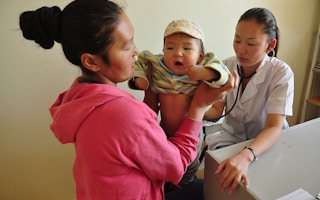Imagine your life without electricity: no television, computer, internet or mobile phone, no lighting at night (other than by candle or kerosene lamp) to read books, study, or walk on the street.
It’s not only boring, lonely and disconnecting—lack of access to electricity limits your personal development and productivity. And more importantly, it can be deadly.
Energy is a critical enabler of quality health care services. For example, mothers in childbirth require immediate medical attention, and unlike other medical procedures, childbirth cannot wait until morning. Without electricity, health facilities can’t have adequate lighting or operate basic medical equipment such as a fetal heart rate monitor.
Health facilities also need energy for vaccine storage, access to clean water, equipment sterilisation, support emergency and surgical care, basic diagnostics and laboratory technology, and e-health. As disease patterns change, even more power will be required to expand services for prevention and treatment of non-communicable diseases such as cancer, diabetes and hypertension.
Despite this basic—and critical—need, clinics, hospitals, and health workers throughout developing Asia often lack access to power. Around one billion people in the region can access only health facilities with unreliable electricity, or none at all. For instance, 46 per cent of Indian health facilities serving an estimated 580 million people, lack electricity, and many more have only an unreliable supply.
To make matters worse, many doctors and nurses simply won’t work at health clinics that don’t have outdoor lighting for their safety, or electricity for running essential medical devices. These facilities can’t attract and retain skilled health workers, especially in rural areas.
Energy access makes communities healthier places because it improves living conditions for residents. For example, street lighting provides safety and security, reduces crime, and encourages healthy activities like sports after dark.
Reliable and affordable energy is critical to achieve good health and wellbeing for all. To mainstream energy into health projects, though, we need to think beyond health sector solutions and foster closer collaboration while leveraging synergies between the health and energy sectors. Here are 3 entry points.
First, generate data for decision makers. One way to do this is to map the electrification status of infrastructure relevant to people’s health (home, community, schools, health facilities) and link that information with health demographic data to show the connection between health and energy in “Energy-Health Dashboards”.
In India, evidence collected by the Council for Energy and Environment and Water demonstrates that investing in energy can play a major role in delivering rural health care. To do so, Indian rural health facilities would have to define their basic energy requirements and service standards.
An interesting aspect of the health-energy nexus is energy efficiency when designing clinics or hospitals. For instance, health facilities can save substantially by using less air conditioning if they are built to allow proper ventilation and natural cooling. The same with heating and insulated windows.
“
Energy access makes communities healthier places because it improves living conditions for residents.
Second, prioritise off-grid solutions for health facilities when planning community-level energy projects. This is easier said than done, since off-grid electrification efforts are consistently hampered by missing allocations in health facility budgets.
Even if budget is available, it is often cheaper to buy a generator than to invest in solar panels, which can be more expensive to maintain. And let’s not forget setting aside funds for maintenance and training staff.
A way around this is to include electrification from renewable energy sources in basic requirements for health facilities, and maybe for larger facilities to offer tax incentives or grants.
Finally, let the numbers talk. Include health benefits in economic rate of return calculations for clean energy projects to highlight their health impacts, and in doing so make the case for such investments. We have a good example in Mongolia, where the government now mandates new hospitals to invest in clean energy.
The case for clean energy investments to achieve better health is clear. But as long as millions of households and thousands of health facilities remain unelectrified across developing Asia, we must continue to raise awareness about the urgency to invest in electrification of health facilities.
Susann Roth is Senior Social Development Specialist (Social Protection), Sustainable Development and Climate Change Department at ADB, and Filipe Silva is Health Impact Assessment Specialist at Public Health by Design. This post is republished from the ADB blog.











